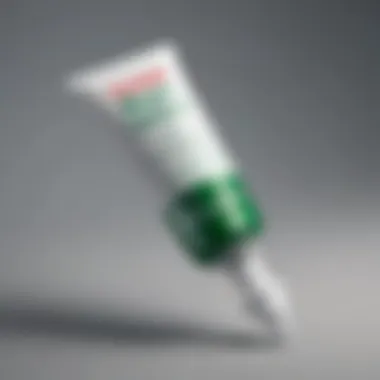Understanding Chlorine Dioxide Toothpaste: Applications and Controversies


Intro
Chlorine dioxide toothpaste has emerged as a topic of significant interest within the field of dental hygiene. This compound, widely recognized for its strong oxidation properties, is gaining traction among consumers seeking effective solutions for oral care. However, its adoption is not without challenges. The dual nature of its benefits and risks forms the core of the ongoing discussion surrounding its use in dental products.
Despite its established applications in water treatment and disinfection, the incorporation of chlorine dioxide into toothpaste raises several questions about efficacy and safety. The potential for improving oral health, combating bad breath, and reducing pathogens must be balanced against concerns regarding its impact on oral tissues and long-term effects on dental health.
This article endeavors to navigate this complex landscape, drawing from existing scientific literature and regulatory frameworks. The discussion will focus not only on the biochemical mechanics underlying chlorine dioxide's effectiveness but also on the controversies that shape consumer perception and regulatory oversight. Understanding these elements is vital for students, researchers, educators, and professionals involved in dentistry and public health.
Prolusion to Chlorine Dioxide
Chlorine dioxide has emerged as a vital substance in various sanitation and disinfection practices. Its relevance extends into oral hygiene through the introduction of chlorine dioxide toothpaste. This section primarily explores the essential properties of chlorine dioxide and its historical usage, providing insights necessary for understanding its application in dental products.
Chemical Properties
Chlorine dioxide is a chemical compound with the formula ClO₂. It exists as a gas at room temperature but is commonly stabilized in aqueous solutions for use in various applications. The compound is a strong oxidizing agent, which allows it to effectively kill bacteria, fungi, and viruses. This property is crucial for any oral hygiene product, as many mouth-related ailments are caused by microbial growth.
The oxidative properties of chlorine dioxide also mean that it does not leave harmful residues. In comparison to chlorine, another common disinfectant, chlorine dioxide is less irritating to mucous membranes. This characteristic is significant for a toothpaste formulation that would come into contact with sensitive oral tissues. Furthermore, studies indicate that chlorine dioxide can act selectively, targeting harmful microbes while preserving beneficial bacteria in the oral cavity. This selectivity supports oral health without compromising the natural microbiome.
Historical Context
The use of chlorine dioxide dates back to the early 20th century. Initially developed for water treatment, its efficacy against pathogens led to wider adoption in various disinfection processes. By the 1970s, chlorine dioxide was recognized for its ability to eliminate biofilms, a significant concern in both public health and industrial settings.
With the push for enhanced dental care products, researchers began to focus on chlorine dioxide for oral hygiene purposes. The transition from water treatment to dental products illustrates the versatility of chlorine dioxide, shaped by both scientific understanding and market needs. Over the years, several studies have emerged analyzing its application in mouthwashes and toothpastes, paving the way for its acceptance and, at times, controversy within the dental community.
Chlorine dioxide toothpaste captures the interest of consumers seeking effective solutions for oral challenges like bad breath and plaque buildup. However, this transition has not been without debate, as discussions continue on the safety and efficacy of its use. Understanding this context provides a foundation for exploring its applications and addressing some of the potential issues that arise as it becomes part of everyday dental care.
Chlorine Dioxide in Oral Hygiene
Chlorine dioxide is gaining attention in the field of oral hygiene, primarily for its potential benefits in managing oral health issues. The use of chlorine dioxide in toothpaste aligns with the growing trends towards effective yet alternative dental care solutions. The practical application of this chemical in oral hygiene signifies a potential shift away from conventional methods. Its relevance and effectiveness should not be dismissed without proper consideration.
Mechanism of Action
Chlorine dioxide acts primarily as an oxidizing agent. When applied to the oral cavity, it releases oxygen and creates a molecule that can react efficiently with bacteria. This mechanism is advantageous because it targets a broad spectrum of bacteria responsible for dental plaque and bad breath. Unlike traditional antibacterial agents, which often focus on killing bacteria, chlorine dioxide alters the environmental conditions in which bacteria thrive. By disrupting metabolic processes, it results in reduced bacterial viability. This allows it to provide cleaning benefits while preserving some of the necessary bacteria required for a healthy oral microbiome. Understanding this mechanism sheds light on why it could complement or even replace existing oral hygiene products.
Chemical Reactions in Plaque Control
The formation of dental plaque is a complex process, influenced by various factors, including dietary habits and oral hygiene practices. Chlorine dioxide can interfere with this process through specific chemical reactions. When chlorine dioxide is introduced into the mouth, it reacts with the compounds produced by bacteria within plaque. These reactions breakdown polysaccharides and proteins, which are essential for plaque adherence to teeth.
Moreover, chlorine dioxide's oxidizing nature helps dissolve the biofilm matrix that protects plaque. A significant advantage here is that it is effective against resistant strains of bacteria that common toothpaste more conventional methods may not address. Maintaining a decrease in plaque accumulation can lead to improved gum health and ultimately reduce the risk of cavities and periodontal disease. Understanding these interactions provides insights into how chlorine dioxide toothpaste might change the landscape of oral care.
Efficacy of Chlorine Dioxide Toothpaste
The efficacy of chlorine dioxide toothpaste is a significant aspect of oral hygiene that draws attention from both consumers and professionals. With growing interest in alternative dental treatments, understanding how effective this compound is can inform choices about oral care products. This section examines several key areas related to the effectiveness of chlorine dioxide in toothpastes, particularly focusing on its antimicrobial properties, ability to combat halitosis, and role in preventing cavities.
Antimicrobial Activity
Chlorine dioxide exhibits substantial antimicrobial activity against a wide range of pathogens. It disrupts the cellular processes of bacteria, leading to cell lysis and death. In clinical studies, it has shown effectiveness against Streptococcus mutans, a primary bacterium responsible for dental caries.
Several points to note regarding its antimicrobial activity include:


- Understanding Resistance: Unlike traditional antibiotics, chlorine dioxide does not lead to a significant development of bacterial resistance. This can make it a valuable asset in oral hygiene.
- Broad Spectrum: It effectively targets both gram-positive and gram-negative bacteria, illustrating its versatility.
- Clinical Evidence: Research demonstrates that chlorine dioxide significantly reduces bacterial load compared to standard toothpaste with fluoride.
Due to these attributes, users may find that products containing chlorine dioxide could provide a greater level of protection against harmful bacteria in their mouths than some conventional options.
Impact on Halitosis
Bad breath, or halitosis, is a common problem affecting many individuals. Chlorine dioxide toothpaste may address this issue effectively. It operates by neutralizing volatile sulfur compounds (VSCs), which are often responsible for unpleasant odors in the mouth.
Consider the following aspects of its impact on halitosis:
- Immediate Effect: Many users report noticeable improvement in breath freshness shortly after brushing.
- Duration of Effect: The halitosis-fighting qualities of chlorine dioxide tend to last longer than many standard mouth rinses.
- Enhancing Oral Environment: By reducing the bacteria responsible for creating foul odors, it may contribute to overall better oral health.
Research substantiates these claims, highlighting that toothpaste with chlorine dioxide significantly improves breath freshness when compared to those without this ingredient.
Role in Cavity Prevention
Preventing cavities is a primary concern in dentistry. Chlorine dioxide has demonstrated potential in this area due to its dual action of reducing bacteria and promoting a healthy oral environment. Studies show that it not only kills bacteria but can also inhibit the formation of biofilms that protect these bacteria.
Key points regarding its role in cavity prevention are:
- Reduced Plaque Formation: Regular use can lead to lower plaque levels, which is critical for cavity prevention.
- Synergistic Effects: When used in conjunction with fluoride, chlorine dioxide may enhance cavity-prevention strategies.
- Dental Community Insights: Some dental professionals advocate for chlorine dioxide toothpaste as a supplementary option rather than a primary treatment.
Through these mechanisms, consumers using chlorine dioxide toothpaste may see a decline in cavity incidents while improving overall oral health.
Safety Concerns
The discussion around chlorine dioxide toothpaste cannot overlook the critical aspect of safety. Understanding the potential risks involved is essential for both consumers and professionals. While the chemical offers various benefits in oral hygiene, it also raises several safety questions that need addressing. This section outlines health risks associated with its usage, regulatory positions taken by authorities, and the role of public perception intertwined with misinformation.
Health Risks Associated with Usage
Chlorine dioxide, when misused, can pose considerable health risks. Though generally recognized as safe in controlled applications, the concentrated forms can lead to irritation or damage to mucous membranes. For instance, people who ingest large quantities, either intentionally or accidentally, may experience nausea, vomiting, or diarrhea.
Additionally, some studies suggest that prolonged exposure to chlorine dioxide can lead to respiratory distress. The potential to develop allergies or sensitivities is another risk worth noting. Therefore, understanding proper usage and adherence to recommended dosages is crucial for mitigating these dangers. Regular consultation with dental professionals can guide the safe application of this chemical in personal care.
Regulatory Stances
Regulatory reactions to chlorine dioxide’s use in toothpaste vary significantly across regions. The United States Food and Drug Administration (FDA) and the European Commission have shared concerns but differ in their specific stances. The FDA has classified chlorine dioxide as a significant antimicrobial agent, yet it emphasizes the necessity of comprehensive testing before general market approval. The European Food Safety Authority (EFSA) remains more cautious, often hesitating to acknowledge it as safe for oral hygiene products without extensive evidence.
These official positions stem from ongoing debates in the scientific community regarding safety and efficacy. As such, consumers must stay informed about the legal status of chlorine dioxide-containing products in their countries. Adhering to guidelines set forth by trusted health authorities can help individuals make safer choices.
Public Perception and Misinformation
Public perception about chlorine dioxide toothpaste is complex. Many individuals are unaware of the distinctions between safe and unsafe usages, leading to widespread misunderstanding. This confusion is compounded by the availability of misinformation through social media platforms and numerous online forums.
"Effective education is important in reducing misconceptions about chlorine dioxide toothpaste, as many believe it presents risks comparable to those found in industrial applications."
Misleading claims often emphasize extreme viewpoints, either portraying the product as a miracle solution or an outright danger. Dental professionals recommend accurately disseminating information to prevent harmful misuse.
The role of credible sources, such as the American Dental Association, cannot be overstated. Relying on professional guidance can help reshape public perceptions while addressing unfounded fears. Consumers benefit from a balanced view, allowing them to weigh risks and rewards judiciously when considering chlorine dioxide toothpaste.
Ultimately, safety remains a priority. Understanding the risks, regulatory guidelines, and addressing public perceptions will enhance informed decision-making about using chlorine dioxide in oral hygiene products.


Comparative Analysis with Other Toothpaste Options
Analyzing chlorine dioxide toothpaste in relation to other types of toothpaste is essential for a complete understanding of its position in oral health. This comparison uncovers various elements such as efficacy, ingredients, and consumer preferences. Each type of toothpaste offers unique benefits and considerations that can inform user choices.
Fluoride Toothpaste
Fluoride toothpaste remains a staple in oral care due to its proven ability to prevent cavities and strengthen enamel. Fluoride works through a process known as remineralization, where it helps restore lost minerals to the tooth structure. This protective effect is supported by numerous studies and endorsed by dental professionals.
Key points to note about fluoride toothpaste:
- Efficacy in Cavity Prevention: Studies show fluoride toothpaste can significantly reduce the incidence of caries.
- Availability: Widely available in various formulations, including flavors for children.
- Regulatory Approval: Strong backing from dental associations and regulatory bodies worldwide.
Despite the extensive research supporting fluoride, some consumers express concern about its potential toxicity when ingested in large amounts. This has led to a growing interest in alternative options, including chlorine dioxide toothpaste.
Natural Alternatives
Natural toothpaste alternatives have seen a rise in popularity as consumers increasingly seek chemical-free solutions. Products often contain ingredients like baking soda, essential oils, and herbal extracts. These alternatives are appealing to those concerned about synthetic additives, but their effectiveness varies.
Considerations when looking at natural alternatives:
- Varied Effectiveness: Natural ingredients may not have the same cavity-fighting potential as fluoride or chlorine dioxide.
- Ingredient Transparency: Consumers can feel more confident about what they put in their mouths.
- Market Growth: The natural toothpaste market has expanded as more brands emerge, focusing on organic and eco-friendly products.
While many find these natural solutions appealing, questions regarding their efficacy in plaque control and decay prevention still remain.
Activated Charcoal
Activated charcoal toothpaste has gained traction, particularly on social media, where it is promoted for teeth whitening and detoxification. The claims suggest that activated charcoal can absorb toxins and stains from the teeth. However, scientific support for these claims is limited.
Points to consider about activated charcoal:
- Potential Abrasiveness: Some studies indicate it can be abrasive, leading to enamel wear over time.
- Limited Efficacy Data: There is insufficient evidence to confirm significant whitening or health benefits.
- Regulatory Concerns: It lacks the backing of authoritative dental organizations, raising questions on safety.
These drawbacks highlight the need for caution and further investigation into activated charcoal as a primary dental care option.
"In evaluating the best toothpaste for individual needs, a careful consideration of ingredients and proven efficacy is crucial."
In summary, the comparative analysis reveals that while chlorine dioxide toothpaste offers specific advantages, its place alongside fluoride, natural alternatives, and activated charcoal depends on consumer priorities. As this field evolves, understanding these nuances will aid users in making informed decisions.
Practical Considerations for Users
The use of chlorine dioxide toothpaste raises several practical factors for potential users. Understanding these elements is vital for effective application and to mitigate risks. Chlorine dioxide can be an important player in oral hygiene, but users need to be well-informed to ensure they reap the benefits while avoiding possible pitfalls.
Dosage and Application Guidelines
Proper dosage and application are crucial when using chlorine dioxide toothpaste. Users should follow the guidelines provided by manufacturers to maximize efficacy and safety. Typically, a pea-sized amount is sufficient for a single use. It's important to gently brush all surfaces of the teeth, including the front, back, and chewing surfaces. Adequate brushing time of at least two minutes is generally recommended.
To get the best results, users should:
- Use twice a day: Regular usage helps in controlling plaque and maintaining fresh breath.
- Avoid swallowing: This toothpaste is not meant to be ingested, so rinsing thoroughly after brushing is necessary.
- Follow with water rinse: Using water to rinse after brushing can help clear out any residual product, safeguarding against any irritation.


"Adhering to proper application guidelines can significantly enhance the benefits of chlorine dioxide toothpaste while minimizing potential side effects."
Monitoring personal reactions to the product is wise. If any irritation occurs, it is advisable to discontinue use and consult a dental professional.
Long-term Use Impacts
The long-term impacts of using chlorine dioxide toothpaste are an essential area for consideration. While short-term benefits may appear promising, extended exposure can lead to varied consequences. Research into long-term safety is still emerging. Thus, caution is prudent.
Some potential long-term concerns include:
- Tooth Sensitivity: Continuous use might affect enamel, leading to increased sensitivity in some individuals.
- Microbiome Disruption: A significant characteristic of chlorine dioxide is its antimicrobial action. While this can be beneficial, altering the oral microbiome could have unforeseen effects.
- Gum Health: Prolonged use might also influence gum health. Regular dental check-ups can help monitor any issues early on.
Ensuring a balanced approach to oral health by combining chlorine dioxide toothpaste with professional dental care is recommended. Engaging with a dentist can help determine if this toothpaste remains suitable after long-term use.
Maintaining awareness of your oral health will aid in decision-making regarding the continuation or cessation of chlorine dioxide toothpaste use.
Consumer Trends and Market Availability
The landscape of toothpaste is evolving, particularly with the rise of chlorine dioxide formulations. Understanding consumer trends and market availability is essential for grasping how these products fit into the broader dental care ecosystem. As consumers become more aware of oral hygiene options, they seek products that promise effectiveness and safety. This awareness leads to a demand for innovative ingredients, of which chlorine dioxide is a prominent example.
Growth of Specialty Toothpaste Brands
The development of specialty toothpaste brands has been significant over the last few years. Consumers show a growing preference for products that cater to specific needs. Brands focusing on chlorine dioxide toothpaste have gained attention due to claims of enhanced antibacterial properties. The effectiveness of chlorine dioxide in tackling issues such as halitosis and plaque control drives brand differentiation in the marketplace.
These brands often emphasize their scientific foundations and product transparency. By educating consumers about the benefits and potential risks of chlorine dioxide, they engage a more informed audience. This trend reflects not only a shift in consumer preferences but also a move towards products developed with a scientific basis. As specialty brands rise, traditional toothpaste options may face a decline in market share, further reshaping the retail environment.
Online vs. Traditional Retail Outlets
The choice between online and traditional retail outlets significantly influences the availability of chlorine dioxide toothpaste. Online shopping offers convenience, as consumers can access a wider range of products from various brands without geographic limitations. Websites like Amazon and brand-specific platforms provide customers ample options to compare ingredients and read reviews. This ease of access can create a more comprehensive understanding of chlorine dioxide toothpaste and its unique qualities.
Conversely, traditional retail stores still play a crucial role. Consumers often prefer in-person shopping for dental care products to physically inspect packaging and ingredients before making a purchase. Supermarkets and pharmacies feature shelves dedicated to oral hygiene, making it easier to explore various brands at once. However, the prevalence of online shopping continues to grow, indicating a shift in how consumers obtain their dental products.
In summary, the dynamics of consumer behavior surrounding chlorine dioxide toothpaste are influenced by various factors, including brand innovations and shopping preferences. Understanding these trends offers valuable insights into the current and future market landscape for specialty toothpaste brands.
Future Directions in Research
The exploration of chlorine dioxide toothpaste is still in its early days. Continued research is essential for a deeper understanding of its applications and implications. This section highlights future directions in research concerning chlorine dioxide toothpaste, focusing on innovations in dental products and the need for clinical trials and studies.
Innovation in Dental Products
Researchers are increasingly looking for ways to enhance the formulation of chlorine dioxide toothpaste. Innovations may involve developing new delivery mechanisms and combinations with other active ingredients to improve efficacy and safety. The potential exist to create specialized products targeting specific oral health issues such as gum disease or tooth sensitivity. Also, improvements in taste and texture can make the product more appealing to consumers.
Advancements in technology will play a critical role in these innovations. For example, nanotechnology could allow for better penetration of active ingredients, delivering more effective treatment while minimizing side effects. Innovations could result in toothbrushes that dispense the toothpaste more effectively, ensuring an even coat.
Future research must focus on assessing consumer needs and preferences. Understanding user behavior can inform design and marketing strategies. A consumer-oriented approach could lead to adaptations that enhance user experience while maintaining dental efficacy.
Clinical Trials and Studies
The importance of clinical trials cannot be overstated in the context of chlorine dioxide toothpaste. Rigorous studies are required to establish the safety and efficacy of this product. Clinical trials should measure specific outcomes such as reduction in plaque, gum health improvement, and overall oral hygiene enhancement when using chlorine dioxide toothpaste.
Researchers should aim for a variety of studies, including randomized controlled trials and comparative studies with existing products. This comprehensive approach can illuminate where chlorine dioxide stands in relation to fluoride toothpaste or natural alternatives.
Moreover, long-term studies are crucial for understanding the impact of prolonged use of chlorine dioxide. Questions about cumulative effects and potential health risks need to be addressed systematically.
The conclusions from these trials will guide regulatory bodies in assessing the viability of chlorine dioxide toothpaste as a recommended oral hygiene product.
In summary, the future of chlorine dioxide toothpaste is promising but requires extensive research. Innovation in product formulations and stringent clinical trials will shape the next steps for this emerging dental care option.







